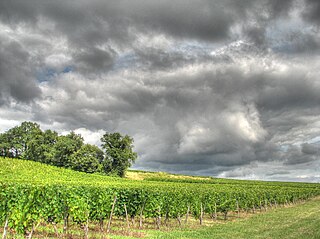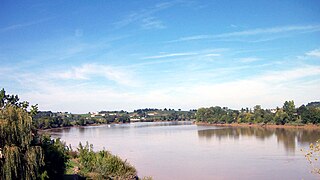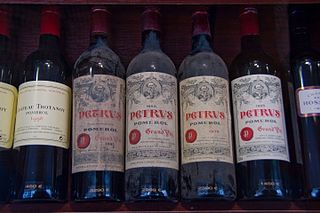 W
WBlaye is a wine region in Bordeaux, centred on the town of Blaye, producing both red and white wine, plus a small amount of rosé and sparkling wine. It is located on the right bank of the River Gironde, and surrounds Côtes de Bourg.
 W
WThe wine regions of Bordeaux are a large number of wine growing areas, differing widely in size and sometimes overlapping, which lie within the overarching wine region of Bordeaux, centred on the city of Bordeaux and covering the whole area of the Gironde department of Aquitaine.
 W
WCadillac is an Appellation d'Origine Contrôlée (AOC) for sweet white wine from the Bordeaux wine region in France. It is located within the Entre-Deux-Mers subregion of Bordeaux. It takes its name from the town of Cadillac.
 W
WCôtes de Bourg is an Appellation d'origine contrôlée (AOC) for Bordeaux wine situated around the small town of Bourg-sur-Gironde near Bordeaux, France. The first vineyards in the area were founded by the Romans. In the Middle Ages, Bourg was a major port for wine and the vineyards developed at the same tempo as the estuary traffic. The Côtes de Bourg appellation, in the north of the patchwork of Bordeaux wines, took its first steps on the east bank of the Gironde. At the time, the inhabitants of Bourg were fishermen, sailors or winemakers and the latter benefited from the perfect combination of a commercially minded town and a soil made for the vine.
 W
WEntre-Deux-Mers is a French region, well known as a Bordeaux wine growing region. The geographical area is situated between the rivers Garonne and Dordogne, and is bounded in the east by the border of the Gironde department and in the west by the Bec d'Ambès, the confluence of the Garonne and the Dordogne.
 W
WFronsac is a wine growing region named after the commune of Fronsac on the right bank of the Gironde estuary in Bordeaux. It includes the following communes: La Rivière, St.-Germain-la-Rivière, St.-Aignan, Saillans, St.Michel-de-Fronsac, Galgon, and Fronsac. Canon Fronsac AOC is a sub-appellation contained entirely within Fronsac AOC in the southern area nearest the Dordogne river.
 W
WGraves is an important subregion of the Bordeaux wine region. Graves is situated on the left bank of the Garonne River, in the upstream part of the region, southeast of the city Bordeaux and stretches over 50 kilometres (31 mi). Graves is the only Bordeaux subregion which is famed for all three of Bordeaux' three main wine types—reds, dry whites and sweet wines—although red wines dominate the total production. Graves AOC is also the name of one Appellation d'origine contrôlée (AOC) which covers most, but not all of the Graves subregion.
 W
WHaut-Médoc is an Appellation d'Origine Contrôlée (AOC) for wine in the Bordeaux wine region of southwestern France, on the Left Bank of the Gironde estuary. Covering a large part of the viticultural strip of land along the Médoc peninsula, the zone covers approximately 60 kilometres (37 mi) of its length.
 W
WMontagne-Saint-Émilion is an Appellation d'origine contrôlée (AOC) for wine in the Bordeaux wine region of France, where it is situated in the Libourne subregion on the right bank of the Dordogne. It was granted AOC status on 14 November 1936, and the AOC designation granted to the wines which have been harvested on the land of the Montagne commune or in its hamlets, Parsac and Saint-Georges. 1,570 hectares of vine planted areas have belonged to the appellation in 2005, with a production of 74,130 hl.
 W
WPauillac is a wine growing commune (municipality) and appellation d'origine contrôlée within Haut-Médoc in Bordeaux, centred on the small town of Pauillac. Hugh Johnson has said, "If one had to single out one commune of Bordeaux to head the list, there would be no argument. It would be Pauillac.". Pauillac includes three of the five premier cru châteaux of Bordeaux: Latour, Lafite Rothschild and Mouton Rothschild. The wines of Pauillac are often considered the quintessence of Bordeaux wines.
 W
WPessac-Léognan is a wine growing area and Appellation d'Origine Contrôlée, in the northern part of the Graves region of Bordeaux. Unlike most Bordeaux appellations, Pessac-Léognan is equally famous for both red and (dry) white wines, although red wine is still predominant. It includes the only red-wine producer outside the Haut-Médoc classified in the Bordeaux Wine Official Classification of 1855, the premier cru Château Haut-Brion, and also includes all of the châteaux listed in the 1953/59 classification of Graves. These classed growths account for a third of the wine produced in Pessac-Léognan.
 W
WPomerol is a French wine-growing commune and Appellation d'origine contrôlée (AOC) within the Libournais in Bordeaux. The wine produced here is predominately from Merlot with Cabernet Franc playing a supporting role. Unlike most other Bordeaux communes, there is no real village of Pomerol, although there is a church. The houses are set among the vineyards.
 W
WPuisseguin-Saint-Émilion is an Appellation d'origine contrôlée (AOC) for wine in the Bordeaux wine region of France, where it is situated in the Libourne subregion on the right bank of the Dordogne. It was granted AOC status on 14 November 1936, and the AOC designation granted to the wines which have been harvested on the land of the Puisseguin commune. 753 hectares of vine planted areas have belonged to the appellation in 2005, with a production of 34,648 hl.
 W
WIn the Bordeaux wine region there are seven regional Appellations d'origine contrôlée (AOCs) that may be used throughout the Gironde department. These are Bordeaux Rouge AOC, Bordeaux Supérieur Rouge, Bordeaux Clairet, Bordeaux Rosé, Bordeaux Blanc, a dry white, Bordeaux Supérieur Blanc, a sweet white, and Crémant de Bordeaux, a sparkling méthode traditionnelle wine. The regional appellations together form the largest world-class wine vineyard, making up more than half of the production of the prestigious Bordeaux wine region, and representing more than 55% of all Bordeaux wines consumed in the world.
 W
WSaint-Émilion is an appellation d'origine contrôlée (AOC) for wine in the Bordeaux wine region of France, where it is situated in the Libourne subregion on the right bank of the Dordogne. Saint-Émilion is registered as a World Heritage Site by UNESCO, the United Nations Educational, Scientific and Cultural Organization.
 W
WSaint-Estèphe is an Appellation d'Origine Contrôlée (AOC) for red wine in the Bordeaux region, located in the Médoc subregion. It takes its name from the commune of Saint-Estèphe and is the northernmost of the six communal appellations in Médoc. Five classified growths of 1855 are located within the appellation area. Saint-Estèphe has held AOC recognition since 1936.
 W
WSaint-Georges-Saint-Émilion is an Appellation d'origine contrôlée (AOC) for wine in the Bordeaux wine region of France, where it is situated in the Libourne subregion on the right bank of the Dordogne. It was granted AOC status on 14 November 1936, and the AOC designation granted to the wines which have been harvested on the land of the Saint-Georges-Saint-Émilion hamlet, which is part of Montagne commune. 192 hectares of vine planted areas belonged to the appellation in 2005, with a production of 9,333 hl.
 W
WSaint-Julien is an Appellation d'Origine Contrôlée (AOC) for red wine in the Bordeaux region, located in the Médoc subregion. It takes its name from the commune Saint-Julien-Beychevelle and is one of the six communal appellations in Médoc. A number of classified Bordeaux estates are located within the appellation.
 W
WSainte-Croix-du-Mont is an Appellation d'origine contrôlée (AOC) for sweet white wine from the Bordeaux wine region in France.
 W
WSauternes is a French sweet wine from the region of the same name in the Graves section in Bordeaux. Sauternes wine is made from sémillon, sauvignon blanc, and muscadelle grapes that have been affected by Botrytis cinerea, also known as noble rot. This causes the grapes to become partially raisined, resulting in concentrated and distinctively flavored wines. Due to its climate, Sauternes is one of the few wine regions where infection with noble rot is a frequent occurrence. Even so, production is a hit-or-miss proposition, with widely varying harvests from vintage to vintage. Wines from Sauternes, especially the Premier Cru Supérieur estate Château d'Yquem, can be very expensive, largely due to the very high cost of production. Barsac lies within Sauternes and is entitled to use either name. Somewhat similar but less expensive and typically less-distinguished wines are produced in the neighboring regions of Monbazillac, Cérons, Loupiac and Cadillac. In the United States, there is a semi-generic label for sweet white dessert wines known as sauterne without the "s" at the end and uncapitalized.